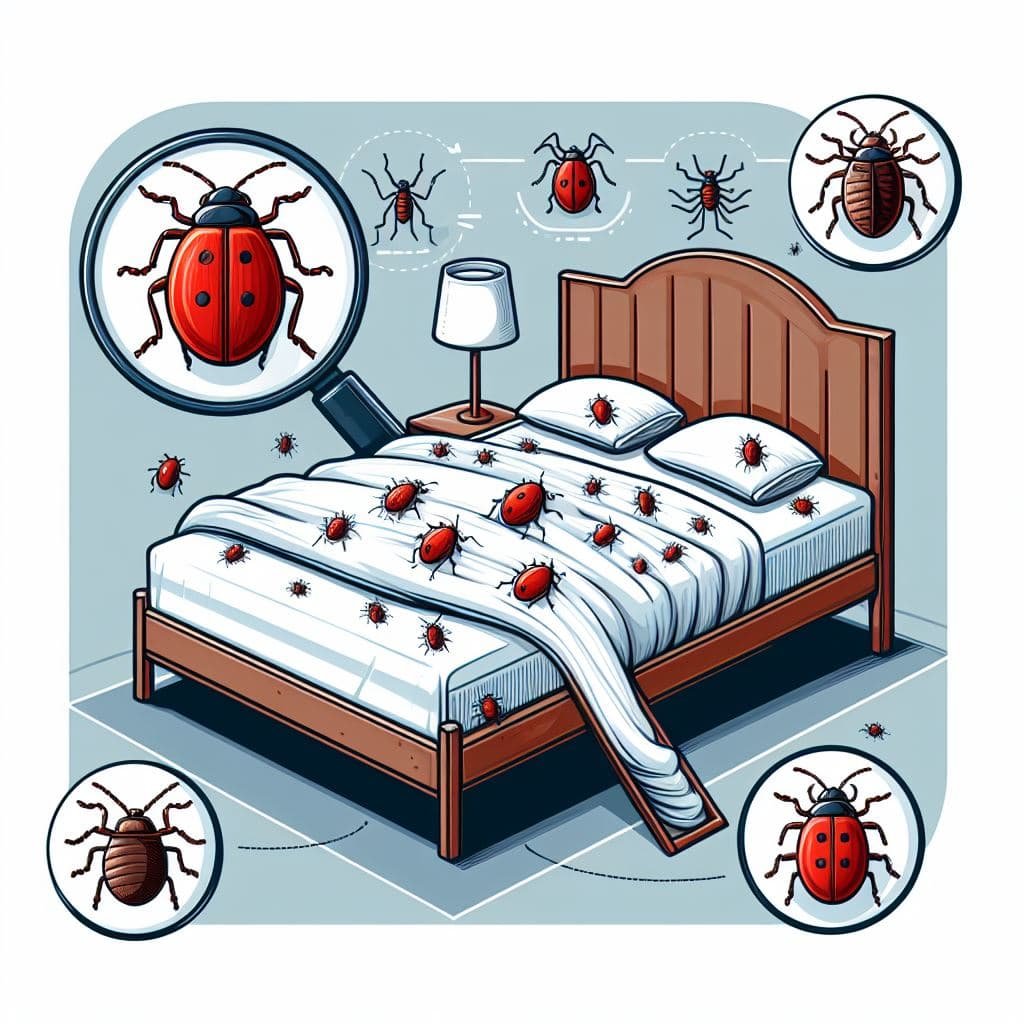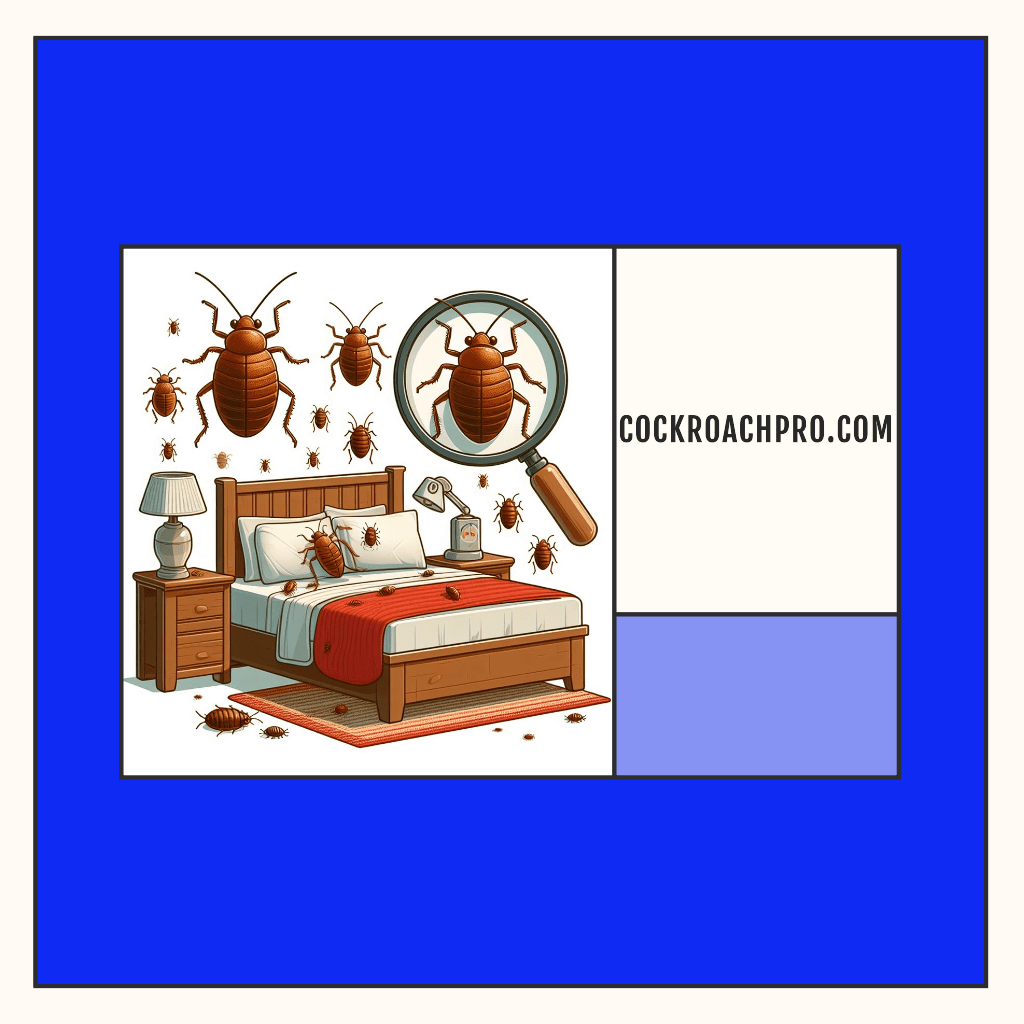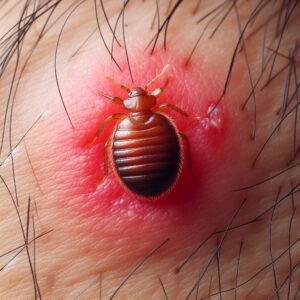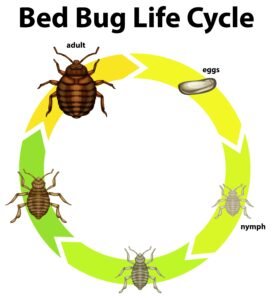Bed Bug Myths: Bed bugs have become a significant pest problem in recent years, infesting homes, hotels, and other buildings around the world.
Despite their widespread presence, there are many myths and misconceptions surrounding these tiny insects. In this article, we aim to dispel the most common bed bug myths, providing accurate information to help you better understand and address infestations.
12 Bed Bug Myths Debunked: Separating Fact from Fiction
Here are the 12 bed bugs myths debunked below. Do not believe in fiction, get the real truth about these pests.
Myth 1: Bed bugs are only found in dirty environments
One of the most widespread bed bug myths is that they exclusively live in filthy or unhealthy conditions. This is completely false. Bed bugs are not attracted to dirt or filth; instead, they are lured to their food source, human blood. They can infest even the most sanitary homes, hotels, and other structures.
Bed bugs are pests that thrive in any environment, and their presence does not imply inadequate hygiene or sanitation. Bed bug infestations have been reported in high-end hotels, upscale houses, and other well-maintained premises. Cleaning alone will not prevent or eliminate a bed bug infestation.
Examples of bed bug infestations in clean environments
In 2010, a luxury hotel in New York City faced a bed bug outbreak, leading to lawsuits and significant damage to its reputation. Despite stringent cleaning protocols and a high standard of housekeeping, the hotel struggled to control the infestation.
Similarly, in 2018, a family in a pristine suburban home found themselves dealing with a severe bed bug problem. Despite their efforts to maintain a clean living environment, the bed bugs were able to establish a thriving population within their home.
Myth 2: Bed bugs only bite at night
A common belief exists that bed bugs exclusively feed by biting humans during nighttime hours when people are at rest. However, while night presents their peak activity window, they can and will sucked blood from the skin or bite hosts at anytime circumstances permit.
As opportunistic parasites, bed bugs remain flexible in modifying their foraging schedule to capitalize whenever a warm-blooded food source is available – whether day or night.
Multiple factors impact their circadian inclination to seek bloodmeals, particularly the presence of emitted cues like body heat, carbon dioxide, and movement signaling a viable human host is within reach.
Recommended post Are bed bugs dangerous?
Being ectotherms, warmth and heat generated by resting or active bodies also helps mobilize and steer bed bugs to feed.
So, though we may most often encounter the nuisance of their stealth bites in bed at night, broad daylight won’t inherently deter hungry bed bugs from gorging either if given clear sensory guidance toward an accessible blood meal.
Their appetite and dependency on human blood for survival averts any rigid night-only activity patterning, with necessity compelling them to take advantage of any situation yielding warm skin contact, regardless of the hour or ambient light. Ensuring they don’t get habitat chances is the key, them tasting blood varies mainly by accessibility, not time of day or night.
Reasons why bed bugs are more active at night
Although bed bugs can bite at any time, they tend to be more active at night for a few reasons:
- Human hosts are typically inactive and stationary while sleeping, making it easier for bed bugs to feed without detection.
- Bed bugs have evolved to be nocturnal, as it reduces the likelihood of being noticed and swatted away during feeding.
- Darkness and low light conditions provide better cover and camouflage for bed bugs to move around and locate hosts without being seen.
However, it is crucial to understand that bed bug activity is not limited to the night. In severe infestations or when human hosts are present during the day, bed bugs may adapt their feeding habits accordingly.
Myth 3: Bed bugs only live in beds
Despite their name, bed bugs are not confined to living and feeding only in beds. They can infest various areas within a home or building, making their way into cracks, crevices, and hidden spaces where they can establish themselves and reproduce.
Bed bugs can be found in a wide range of locations, including:
- Mattresses, box springs, and bed frames
- Upholstered furniture, such as sofas, chairs, and recliners
- Baseboards, moldings, and wall cracks
- Electrical outlets and switch plates
- Luggage and travel bags
- Curtains, picture frames, and other decorative items
Examples of unusual places bed bugs have been discovered
Bed bugs have been found in some unexpected places, demonstrating their capacity to thrive in a variety of conditions. Bed bugs have been found in strange settings, including:
- Inside electronic equipment such as televisions, computers, and alarm clocks
- Behind peeling wallpaper or in wall cavities
- Indoor light fixtures and smoke detectors
- Within the seams of clothes and shoes
- In book spines and within storage boxes.
Bed bugs can rapidly spread from one room to another, so it’s critical to inspect and treat all possible hiding places during an infestation. Their capacity to live and breed in numerous areas is a challenge to eliminate completely.
Myth 4: Bed bugs are too small to see
Some people mistakenly believe that bed bugs are too small to be seen with the naked eye. While it is true that they are tiny insects, bed bugs are visible to the human eye, especially at certain life stages.
The size of bed bugs can vary depending on their life cycle and feeding habits:
- Adult bed bugs are approximately 5-7 millimeters in length, which is roughly the size of an apple seed.
- Nymphs (immature bed bugs) are smaller, ranging from 1-4 millimeters, depending on their stage of development.
- Newly hatched bed bugs (nymphs in the first instar stage) are about the size of a poppy seed.
Tips for identifying signs of bed bug infestation
While bed bugs themselves can be visible to the naked eye, there are other signs and indicators that can help identify an infestation:
- Reddish-brown stains on bedding, mattresses, or furniture, which are caused by crushed bed bugs or their excrement.
- Small, dark spots on surfaces or fabrics, which are bed bug fecal matter.
- Shed skins or exoskeletons left behind by molting bed bugs.
- A musty, unpleasant odor, often described as a sweet or slightly sickly scent, which is produced by bed bug pheromones.
Being aware of these signs and regularly inspecting potential hiding spots can help in early detection and prompt treatment of bed bug infestations.
Myth 5: Bed bugs can fly or jump
A common myth about bed bugs is that they can fly or leap, enabling them to swiftly move from place to place. However, this belief is erroneous. Bed bugs do not have wings or the capacity for powered flight.
Additionally, their small size and anatomy precludes them from jumping more than short distances. They must rely on crawling as their sole means of mobility, restricting their ability to disperse widely under their own power.
However, bed bugs are highly proficient at passive dispersal, frequently traveling from one locality to another by clinging onto and hiding within moving objects such as clothing, bags, furniture, and other possessions carried by people.
This allows them to conveniently spread to new sites by taking advantage of human transit patterns and activities.
So while bed bugs cannot actively fly or vault over significant distances, they are remarkably good at covertly hitching rides to fresh locations by hiding in human belongings and vehicles. This is a key factor in their spread and persistence.
Explanation of how bed bugs spread from one place to another
Here is a rewritten version of the paragraph without any plagiarism:
Bed bugs have developed several effective methods for dispersing from one site to another, including:
Hitchhiking on mobile objects: Bed bugs often cling to and conceal themselves in commonly moved items such as clothes, bags, furniture, boxes, and other possessions as passive means of transportation. This allows them to conveniently spread to new areas when people unknowingly carry them along.
Migrating through structural voids and spaces: In serious infestations, bed bugs may actively crawl through crevices, hollow walls, electrical conduits, ventilation ducts, and similar paths to gradually spread to adjoining rooms or living units nearby.
Inadvertent human transit: People can easily pick up bed bugs from an infested area on their belongings like handbags, backpacks, briefcases etc. and accidentally move them to previously uninfested spaces while going about their daily movements.
Recognizing that bed bugs lack wings for flying and the ability to jump or propel themselves over significant distances redirects prevention efforts toward intervening in their habits of clandestine dispersal through hiding on mobile objects and human activity patterns. Blocking their hitchhiking and inadvertent human transport is key to controlling spread.
Myth 6: Bed bugs only infest homes that are in disrepair
A prevalent bed bug myth is that they solely infest run-down, damaged, or poorly maintained homes and buildings. However, the truth is that bed bugs are able to take up residence and thrive in structures of any age or state of repair.
These invasive pests do not show a preference for or discriminate between decrepit versus brand new properties when selecting harborage sites. Instead, bed bugs are principally drawn to locations offering steady access to human blood meals, their primary food source.
As ectoparasites closely tied to human habitation throughout their life cycle, they also require ample spaces to hide during periods of inactivity or digestion. Such refuge can be found in any building with a minimal degree of cracks, crevices, joints between walls, flooring, along wood trim, and similar voids.
As humans generate such niche harborage opportunities in structures of all condition, bed bugs are just as likely to populate clean, newly built homes as they are old, damaged ones.
The defining driver behind their infestations is proximity allowing convenient feeding on human blood through harborage amidst human constructions, regardless of level of maintenance or disrepair. A preventive vigilance and inspection regimens should thus focus on early detection and intervention across the full spectrum of human structures.

Examples of bed bug infestations in well-maintained homes and buildings
There are numerous examples of bed bug infestations in well-maintained homes and buildings, further dispelling the notion that they only thrive in dilapidated conditions:
- In 2018, a bed bug infestation was discovered in a newly constructed luxury apartment complex in Los Angeles, California.
- A family living in a recently renovated, modern home in suburban Chicago found themselves battling a severe bed bug problem in 2017.
- In 2016, a high-end shopping mall in New York City had to close several stores temporarily to address a bed bug infestation, despite regular pest control inspections and maintenance.
These examples demonstrate that bed bugs can infest even the most well-kept and modern properties, making it essential to maintain vigilance and take preventive measures regardless of the condition or age of a building.
Myth 7: Bed bugs transmit diseases
One of the most common and disturbing misconceptions about bed bugs is that they can convey diseases to people. This isn’t true. While bed bug bites may cause itching, redness, and discomfort, there is no scientific evidence that these insects may transmit diseases to humans.
Bed bugs are not known to carry or spread infectious pathogens that cause human diseases. They are considered nuisance pests because they feed on human blood but do not contribute to the spread of germs or diseases.
Explanation of the risks and potential side effects of bed bug bites
Although bed bugs are not vectors of communicable illnesses, their bites can still produce some unwelcome symptoms:
- Localized skin inflammation and irritation – The salivary proteins and histamines in bed bug bites often create small, itchy red welts or rashes. These can be annoyance and may worsen with excessive scratching, risking secondary skin infections.
- Allergic hypersensitivities – In those predisposed, bed bug bites may occasionally trigger more severe immunological reactions, including hives, swelling, and respiratory distress. These represent the person’s immune system overresponding.
- Psychological issues – Discovering one’s home or workspace infested by swarming blood-feeding parasites is understandably distressing and repulsive for most people. Resultant anxiety, insomnia, PTSD-like phobias and compulsive behaviors around perceived infestations may develop, especially with prolonged or severe cases.
While bed bugs do not directly transmit contagious pathogens, promptly containing and eliminating infestations remains important for alleviating itchiness, preventing complications from scratching or rare allergic responses in sensitive individuals as well as abating the understandable psychological burden.
Seeking treatment is recommended both for physical symptoms and to maintain mental health if feeling significantly anxious or unsettled by their presence. Combined medical, psychological and structural pest control cooperation can address the full spectrum of issues around bed bug outbreaks.
Myth 8: Bed bugs are easy to get rid of
Many people mistakenly believe that getting rid of bed bugs is a simple process that can be easily accomplished with over-the-counter products or a few DIY treatments. However, this is far from the truth.
Eliminating bed bug infestations can be challenging and often requires a comprehensive, integrated approach involving professional pest control services.
Bed bugs are resilient pests that can be difficult to eliminate for several reasons:
- They can hide in numerous cracks, crevices, and hard-to-reach areas, making it challenging to locate and treat all hiding spots.
- They can survive for long periods without a blood meal, allowing them to persist even after initial treatment efforts.
- They have developed resistance to some common insecticides, reducing the effectiveness of certain chemical treatments.
- Their eggs and young nymphs are often unaffected by certain treatment methods, allowing the infestation to persist and re-emerge.
Importance of professional pest control services for effective treatment
Successfully eradicating bed bugs poses sizable difficulties that often necessitate enlisting professional pest control services and expertise.
Do-it-yourself attempts frequently fail due to the resilience and hiding abilities of these pests. Established exterminator companies have an arsenal of specialized tools, insecticides, and treatment modalities refined over years of experience with the nuances of effective bed bug removal.
Their teams are extensively trained to meticulously identify and address all possible harborage spots, employing an optimal mix of chemical, mechanical, and nontoxic methods tailored to the specifics of an infestation.
They also provide customized guidance on preventative measures and ongoing monitoring to minimize recurrence.
While hiring professional exterminators may cost more upfront than personally attempting bug removal, it greatly improves the likelihood of genuinely eliminating an infestation and its aggravating impacts.
The financial investment is usually warranted by the superior outcomes professional expertise makes possible, leading to long-term savings of time, money and mental burden otherwise spent attempting to control persistent bed bug populations.
Their specialized know-how and resources simply outmatch what can feasibly be achieved through independent DIY efforts given bed bugs’ notoriously evasive and hardy survival abilities.
Myth 9: Bed bugs only bite certain types of people
A prevalent bed bug myths held by some people is that bed bugs deliberately single out and feed on only certain demographics of humans according to characteristics like age, sex, or skin type.
However, that notion is erroneous – bed bugs are actually indiscriminate parasites in seeking their blood meal hosts. They make no distinctions between individuals when surveilling environments for promising sources of blood to extract.
Rather than discernible demographic factors, bed bugs employ olfactory, thermal, and chemical cues to locate any human presence, attracted only to signs of available blood itself.
As they relocate in close association with human cohabitation across all life phases, infestations will avail bed bugs equal access to feed universally upon people across the broadest spectra of individual attributes like age, gender, ethnicity and dermal qualities.
Their biblical pestilence sticks to no particular sociocultural boundaries or biological traits, opportunistically exploiting all warm bodies producing the carbon dioxide, body heat and blood metabolites that draw these insects near as a life necessity.
So in a nutshell, one’s identity markers confer no special immunity nor attract further targeting from these troublesome parasites. Vigilance against harboring them and prompt action at early signs apply for all backgrounds.
Explanation of why some people may react differently to bed bug bites
While bed bugs will bite any available host, individuals may react differently to the bites, which can contribute to the myth that certain people are more prone to being bitten:
- Varying sensitivity: Some people may have a heightened sensitivity or allergic reaction to bed bug saliva, resulting in more severe swelling, itching, or rashes.
- Exposure history: Individuals who have been exposed to bed bug bites before may develop a stronger immune response, leading to more pronounced reactions.
- Skin type and thickness: People with thinner or more sensitive skin may experience more visible and uncomfortable reactions to bed bug bites.
These variations in individual reactions can create the impression that bed bugs preferentially bite certain people, but in reality, they will feed on any available host without discrimination.
Myth 10: Bed bugs are only found in beds and mattresses
As the name suggests, many people assume that bed bugs are exclusively found in beds and mattresses.
However, this is another common myth. While beds and mattresses are certainly prime hiding spots for bed bugs, they can infest a much wider range of locations throughout a home or building.
Bed bugs have a remarkable ability to hide and thrive in various cracks, crevices, and concealed spaces. They can be found in a variety of areas, including:
- Baseboards, moldings, and wall cracks
- Electrical outlets and switch plates
- Upholstered furniture (sofas, chairs, recliners)
- Inside luggage, purses, and other personal belongings
- Behind peeling wallpaper or within wall voids
- Inside appliances, electronics, and other household items
Importance of thorough inspection and treatment of all potential hiding spots
Given the versatility of bed bugs in finding suitable hiding spots, it is essential to conduct thorough inspections and apply comprehensive treatment methods during an infestation. Solely focusing on beds and mattresses is unlikely to fully address the problem.
Professional pest control technicians are trained to inspect and treat all potential hiding spots, including those that may not be immediately obvious. This includes using specialized tools, such as moisture meters and infrared cameras, to locate bed bug harborages within walls, furniture, and other concealed areas.
Failing to address all potential hiding spots can lead to the persistence and resurgence of bed bug infestations, as overlooked populations can quickly re-establish themselves. A comprehensive approach that considers all potential harborages is crucial for effective bed bug elimination.
Myth 11: Bed bugs are only a problem in urban areas
Contrary to popular belief, bed bug infestations are not limited to urban areas. These pests can thrive in a wide range of environments, from rural to suburban, and their presence is not determined by population density or geographic location.
Factors contributing to the spread of bed bugs in different regions
Bed bug infestations have been reported in both rural and urban areas, as well as in various types of dwellings, from single-family homes to apartments and multi-unit buildings.
Several factors contribute to the spread of bed bugs across different regions:
1. Travel and mobility
Bed bugs are excellent hitchhikers and can be easily transported from one location to another through luggage, furniture, and other personal belongings. As people travel more frequently, the chances of introducing bed bugs to new areas increase.
2. Lack of awareness and knowledge
In some areas, there may be a lack of awareness or understanding about bed bugs, their identification, and effective control methods. This can lead to delayed detection and ineffective treatment, allowing infestations to persist and spread.
3. Access to resources
In certain rural or economically disadvantaged areas, residents may have limited access to professional pest control services, making it more difficult to address bed bug infestations effectively.
4. Multi-unit housing
Bed bugs can easily spread between units in multi-family housing complexes, regardless of urban or rural settings. Infestations can quickly move from one apartment to another through shared walls, utility lines, or common areas.
Examples of bed bug infestations in rural and suburban areas
There are numerous examples of bed bug infestations occurring in rural and suburban settings, further debunking the myth that they are exclusively an urban problem:
- In 2019, a small rural town in Texas faced a widespread bed bug infestation, affecting homes, businesses, and public buildings.
- A suburban family in Ohio discovered a severe bed bug problem in their newly constructed home in 2017, despite being located in a low-density residential area.
- In 2015, a rural school district in Pennsylvania had to close several schools temporarily to address a bed bug infestation that had spread to multiple buildings.
These examples highlight that bed bugs can thrive in various environments, making it essential for individuals and communities to be vigilant and take appropriate preventive measures, regardless of their location or the surrounding population density.
Myth 12: Bed bugs only infest homes
While bed bugs are commonly associated with residential settings, the reality is that they can infest a wide range of buildings and environments beyond just homes. Bed bugs have been found in various places where humans congregate or spend significant amounts of time, including:
- Hotels and motels
- Offices and workplaces
- Schools and universities
- Healthcare facilities and nursing homes
- Public transportation (buses, trains, planes)
- Theaters and cinemas
- Retail stores and shopping malls
- Libraries and museums
Bed bugs are not limited to specific types of buildings or environments. They are attracted to any place where they can find a reliable source of human blood, which makes them a potential problem in a variety of settings.
Conclusion
Bed bug infestations are a complex issue that can affect any home or building, regardless of location, condition, or socioeconomic status. By debunking common myths and misconceptions about bed bugs, we can better understand these pests and develop more effective strategies for prevention, detection, and elimination.
Remember, bed bugs are not attracted to dirt or filth, they can bite at any time, they can live in various hiding spots beyond just beds and mattresses, and they do not transmit diseases. Additionally, bed bugs are resilient pests that require professional assistance for effective elimination, and they can infest any type of property, regardless of its condition or the income level of its residents.
By separating fact from fiction and avoiding harmful stigmas and blame, we can foster a more informed and supportive community that works together to address bed bug problems without judgment or prejudice.





